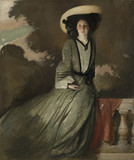John White Alexander was one of the country’s foremost figure painters at the turn of the century. In 1875 he moved to New York to pursue a career in the commercial arts, and he became one of the most successful illustrators working for the publishing firm of Harper & Brothers. Although he continued to support himself as an illustrator during the 1880s, he was determined to become a painter and in 1877 went to Europe to further his studies. He briefly attended life drawing classes at the Royal Academy of the Fine Arts in Munich, where he became part of the circle around J. Frank Currier (1843 -1909), with whom he spent the summers of 1878 and 1879 at Polling, Bavaria. In October 1879 Alexander went with Frank Duveneck (1848-1919) and the "Duveneck boys" to Florence for two years, summering in Venice, where he met James McNeill Whistler (1834-1903).
In 1881 Alexander returned to New York and soon established a reputation painting portraits of notable literary, political, and theatrical figures. In 1884 he made a brief visit to North Africa and studied the work of Diego Velázquez (1599-1660) in Madrid. Recuperating from a debilitating illness, he settled in Paris in 1890, residing there for more than a decade. Alexander participated in French art circles, becoming an intimate of the symbolist painters and writers, renewing his association with Whistler, and exhibiting at the avant-garde Salon of the Société Nationale des Beaux-Arts.
Influenced by French artists and Whistler, he abandoned his dark, heavy Munich style of the 1880s for a fin-de-siècle art nouveau and symbolist aesthetic. He immediately won honors for his evocative figure paintings of beautiful women and was even invited to join the radical secessionist groups in Munich, Vienna, and Brussels.
In 1905 Alexander received a commission to paint murals for the Library of Congress and ten years later undertook an extensive mural project, Apotheosis of Pittsburgh, for Carnegie Institute in Pittsburgh. His last years were spent in the United States, where he continued to be a popular figure painter and portraitist and was active in art circles, becoming president of the National Academy of Design in 1909. Alexander also painted landscape and still-life paintings, although less frequently.
BIBLIOGRAPHY
New York, American Academy of Arts and Letters, John W. Alexander Papers (on microfilm, Archiv. Am. Art) § Pittsburgh, Carnegie Institute, Catalogue of Paintings, John White Alexander Memorial Exhibition, exh. cat., 1916, with introduction by John W. Beatty, annotated "Record of Paintings by John White Alexander: Incomplete List," bibliography § "John W. Alexander Memorial Number," American Magazine of Art 7 (July 1916): 345-81 § Washington, D.C., Smithsonian Institution, National Collection of Fine Arts, John White Alexander (1856 -1915), exh. cat., 1976, with text by Mary Anne Coley § New York, Graham Galleries, John White Alexander, 1856 -1915. Fin-de-Sièle American, exh. cat., 1980, with text by Sandra Leff and Elizabeth Dailey Kvam, lists of collections, honors, and sitters.

